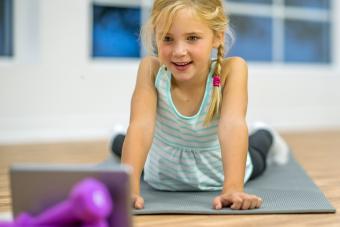
Skill related fitness programs, also called functional movement exercise, enhance athleticism and improve efficiency at every day tasks. These programs usually involve exercises that simultaneously work different muscle groups.
The Dynamic Pattern Theory
Skill related fitness is based on the dynamic pattern theory of motor learning, which states that your brain is more efficient at memorizing and interpreting patterns of movement, as opposed to muscle isolation exercise. The squat exercise, for example, resembles many sport-specific movements. The leg extension machine, in contrast, is an isolation that bears little resemblance to any functional activity.
Using the dynamic pattern theory to design fitness programs may also improve muscle recruitment patterns. The efficiency of a movement is often affected by the order in which muscle fibers are called into play. Rotary sports, such as golf, tennis and kayaking may begin with movements that initiate in the hips, and then follow through in the obliques and the shoulders. The movement will be less powerful if it is initiated in the shoulders.
Difference Between General and Skill Related Fitness
Aerobic and muscular endurance, muscular strength and flexibility are examples of general fitness. Traditional strength-training, aerobic and flexibility exercise programs enhance these physical fitness components. In contrast, balance, coordination, agility, power, reaction time and speed are the skill-related components of fitness.
Skill development and general fitness are not mutually exclusive. Speed, for example, requires cardiovascular fitness and hamstring muscle strength. Muscular strength, as well as intramuscular imbalance will affect static and dynamic balance, as well as coordination. Inadequate flexibility may hinder agility and reaction times.
Balance
Balance is defined as the body's ability to remain centered over its base of support. It is directly related to proprioception, which is the body's awareness of its position in space. Alpine and cross-country skiing, snowboarding, skating and cycling require balance, but it is also needed for non-athletic activities such as walking on ice, balancing on a bus or train or walking on a moving platform at an airport.
Stability ball programs, bosu training and balance board exercises enhance balance. Perform movements that simulate the activity you wish to perform.
Balance is impeded by muscular imbalances. A hamstring/quadriceps imbalance, for example, will cause the legs to hyperextend instead of flex. If this happened on a ski slope, you might fall backwards.
Agility
Agility is defined as the body's ability to respond to external stimuli, change direction and react quickly without losing balance or altering postural alignment. It is directly related to reaction time. Sports coaches use the term "movement time" to describe the period between the end of the reaction time and the movement chosen in response to it. Reducing the movement time is the goal of agility training programs. Competitive martial arts and all ball and racquet sports require agility, but it is also useful in daily activities, such as jumping away from a quickly-approaching car. Medicine ball training, jump rope and agility ladder exercise effectively enhance agility and reduce movement time.
Coordination
Coordination is defined as the harmonious functioning of muscles or groups of muscles in the execution of movements. It's interesting to note that some dictionaries define "uncoordinated" as "lacking planning, method and organization." Harmonious, coordinated movement therefore requires the muscles of the body to act and react in an organized manner. Consider an orchestra. If you put the brass section at the front of the stage, they would drown out the sound of the violins and flutes. The sound would be distorted. Your body works the same way. If your larger muscles work harder than your smaller, stabilizing muscles, your movements will lack harmony, and look uncoordinated. Combining balance and agility training improves coordination, but since there are mental elements to being coordinated, classes that offer aerobic choreography may also be useful.
Skill related fitness programs are not only fun to do; they help you enjoy your favorite sport.







